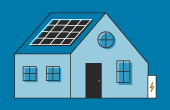For many households in the United States, a 4.5 kW solar system is the right size to significantly cut electricity costs. Want to know the best way to ensure you’re getting the right price for your solar panel installation and maximizing your long-term savings? Compare your solar quotes with the prices that other solar shoppers paid for their 4.5 kW solar systems near you. Learn more about the cost of a 4.5 kW solar system, how much electricity your 4.5 kW system can produce, and what the smartest way is to shop for solar.
Continue readingWhat does a 5,000 watt (5 kW) solar system cost in the U.S.?
5 kW solar systems are near the average size for solar panel installations in the United States, so for those wondering how much solar will cost to install, looking at some price data for 5,000 watts of power is a good place to start. Prices will vary based on the size of your system, the type of equipment you choose, and the state that you live in. Learn more about how much solar panels cost, how much electricity a 5kW system can produce, and the smartest way to shop for solar.
Continue readingHow much does a 6,000 watt (6kW) solar system cost?
If you’ve been looking into going solar, you’ve probably at some point seen quotes for a 6kW solar system. 6kW solar systems are one of the most popular system sizes in the US because in most places they will produce about the right amount of electricity to meet an average household’s daily electrical needs.
Continue readingSilfab solar panels: the complete review
Silfab is a Canada-based solar photovoltaics (PV) manufacturer offering monocrystalline and bifacial solar panels to customers throughout the world. The company was founded in 2010 and is one of the few major solar panel brands to manufacture its products exclusively in North America. Their all-black, SIL NL series of panels are very power dense, and are matched with an unbeatable 30-year warranty. As a result, Silfab is one of the most popular brands in offers to homeowners and businesses shopping for solar on the EnergySage Solar Marketplace.
EnergySage has reviewed the product specifications of each Silfab solar panel series to make your solar research process easier. As the leading online marketplace for homeowners considering solar, EnergySage is uniquely positioned to evaluate the technical specifications of Silfab solar panels and help you compare them to other manufacturers on the market.
Continue readingIntroducing Wallbox: the European-based smart EV charger company
In 2019, the Solar Energy Industries Association declared the 2020s would be the ‘Solar+ Decade”. So far, their designation has come true, and then some: 2020 was the best year ever for energy storage deployment in the US, including at the residential level. But it’s not just energy storage that is being paired with solar; according to our recently released Installer Survey, in 2020, 1 in 12 solar installations also included an electric vehicle (EV) charger, while nearly as many people purchased an EV as purchased a solar panel system nationwide.
But EVs are good for more than just transportation – they are powered by high-capacity batteries, which theoretically could be leveraged to play a similar role as a standard solar-battery, just with more storage capacity. One company that is pioneering this technology–typically called vehicle-to-grid or vehicle-to-home–is Wallbox, a 6-year-old, internationally located smart EV charging company. We had a chance to chat with Wallbox to learn about their products, the promise of vehicle-to-grid technology, and when you can expect to install that in your home. Here’s what we learned:
Continue readingCommunity solar vs. CCAs vs. green power plans: comparing alternative electricity options
At EnergySage, we get a lot of questions about alternative ways to support renewable energy without putting solar panels on your roof. One of the easiest ways to do so is buying electricity from someone other than your utility company. But there are a lot of options out there, each one surrounded by a good deal of misinformation and jargon, making it somewhat difficult to weigh the pros and cons of each.
Continue readingIs residential electricity price going up or down?
If you’re considering whether going solar is a worthwhile financial move for your home, there are essentially two factors that you should look at: 1) the costs associated with solar power, and 2) the rates you pay for electricity from your utility. Going solar makes economic sense when solar electricity costs less than grid electricity.
Continue readingThe Enphase Energy System: what are its four configurations?
One question that homeowners commonly ask during the solar installation process is whether they can power their homes with just solar panels in the event of an outage – typically the answer is no, you’ll also need storage for a safe and reliable setup that can keep the lights on. However, Enphase made headlines in October 2021 with the announcement of a new configuration of the Enphase Energy System which is, in fact, capable of providing off-grid functionality to homeowners without storage installed (with a few caveats).
In a two-part series, we’re explaining everything you need to know about the Enphase Energy System. In part one, we discussed the components that make up the Enphase Energy System. In this article (part two of our series) we’ll explain how the components can be configured into different setups: you can choose from four different configurations, depending on the level of backup you want or need.
Continue readingThe Enphase IQ Battery: the complete review
Enphase is one of the biggest names in solar inverter technology, and in 2019 the company announced its foray into energy storage with the Enphase Encharge, which was rebranded as the Enphase IQ Battery in 2021.
Continue readingThe Enphase Energy System: what are its components?
Enphase recently announced their vision for electric homes: smart, all-in-one home energy systems, which they’ve named the Enphase Energy System. This system can come in four different configurations based on the different components installed. In a two-part series, we’ll be breaking down everything you need to know about the Enphase Energy System to help you determine if one of these set-ups is right for you.
There are a number of products you’ll need for your Enphase Energy System, which will vary depending on the set-up you choose. While most of the components are made by Enphase, others can come from a different manufacturer of your choosing. In this article (part one of our series), we’ll break down all of the various components that you may need. Skip to part two if you’re interested in learning about the different configurations of the Enphase Energy System.
Continue reading




